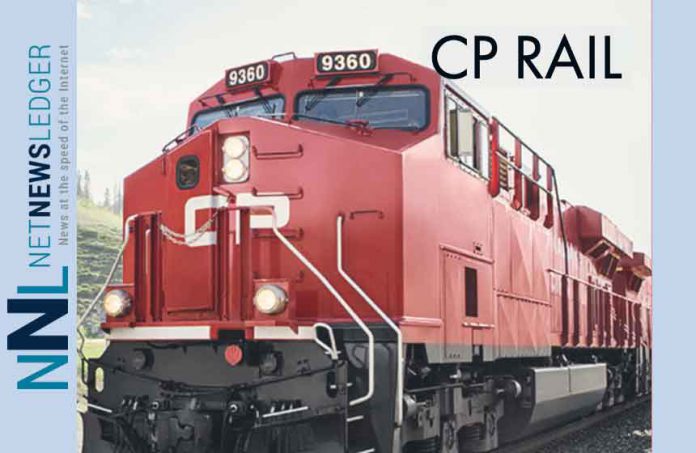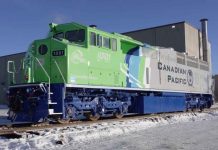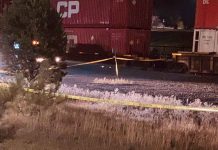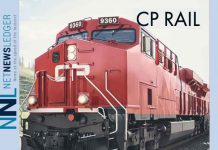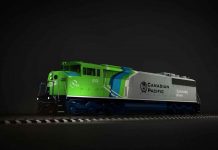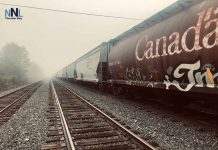OTTAWA – The Transportation Safety Board has provided an update on the ongoing investigation into the derailment of a CP Rail train near Field British Columbia.
On 04 February 2019, Canadian Pacific train 301 was proceeding westward to Vancouver when 99 cars and 2 locomotives derailed at Mile 130.6 of the Laggan Subdivision, near Field, British Columbia. The train crew consisted of a locomotive engineer, a conductor and a conductor trainee. The 3 crew members were fatally injured.
What we know
- The train was a (distributed power) unit grain train composed of 112 covered hopper cars and 3 locomotives.
- The 3 locomotives were positioned at the front, middle and rear of the train.
- Following the derailment, only 13 cars and the tail end locomotive remained on the track.
- The lead locomotive and some of the cars derailed on a curve prior to a bridge.
- The lead locomotive came to rest on its side in a creek.
- A number of derailed cars came to rest on an embankment.
- The remaining cars, including the mid-train remote locomotive piled up behind.
- The accident took place between the Upper and the Lower Spiral Tunnel near Field, BC.
Progress to date
The investigation team has conducted the following information-gathering work:
- Preliminary indications are that a loss of control of the train occurred.
- The train had been stopped with the air brakes applied in emergency at Partridge, the last station prior to the entrance to the Upper Spiral Tunnel.
- A change off between crews had occurred at this location as the previous crew were closing in on their maximum hours of service.
- The occurrence crew had just arrived and boarded the train but were not yet ready to depart. The train had been stopped on the grade, with the airbrakes in emergency for about 2 hours when the train began to move on its own.
- There were no hand brakes applied on the train. The train then accelerated to a speed well in excess of maximum track speed of 20 mph for the tight curves and steep mountain grade and the train derailed.
- Locomotive event recorder data from the lead locomotive has not yet been obtained as the lead locomotive was severely damaged in the derailment.
- Some data has been recovered from the tail-end remote locomotive and work is under way to obtain data from the mid-train remote locomotive.
- The investigation will determine how and why the loss of control took place.
Next steps
There are currently two TSB investigators at the accident site, and two investigators are coordinating efforts from the Calgary office. The team is augmented by investigators from the TSB Engineering Lab and the TSB Human Factors Division.
On site, we will continue to:
- collect data from the accident site,
- collect any available electronic data from the 3 locomotives,
- conduct interviews,
- examine and photograph the wreckage, and
- identify components for further examination by the TSB Engineering Lab.
In addition, we will examine:
- weather conditions and the railway’s winter operating plan,
- train operations specific to the Field Hill,
- operational policies for mountain grade train operations,
- railway training specific to the reliability of air brakes in extreme cold temperatures
- maintenance history of the rolling stock, and
- regulatory requirements.
The TSB’s investigation will determine causes and contributing factors of this accident. Concurrent investigations are being conducted by other agencies and for other purposes. Other investigating agencies include Transport Canada under an extended jurisdiction agreement with Employment and Social Development Canada – Labour Program, and the BC Coroner’s office. The TSB will work with these agencies to ensure that those affected, including the next of kin, are provided with information about the accident and the next steps.
With any significant incident, there are many questions that need to be answered. As you are aware, CP immediately initiated an investigation and since then has collected a significant amount of information which we will continue to analyze in order to determine the cause of the derailment. We have committed to fully cooperate with the Transportation Safety Board (TSB), Transport Canada (TC), and other agencies, and have provided information as requested. Through this concerted effort, we are establishing some key facts and gaining a preliminary understanding of the chain of events. We will provide further updates in due course. Additionally, the TSB will release its own independent findings at a later date.
In the meantime, CP crews, contractors and agencies are working diligently in challenging conditions to remove the damaged rail cars and equipment. We expect this process to take a number of days.

